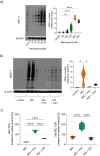Histidine containing dipeptides protect epithelial and endothelial cell barriers from methylglyoxal induced injury
- PMID: 39496731
- PMCID: PMC11535046
- DOI: 10.1038/s41598-024-77891-9
Histidine containing dipeptides protect epithelial and endothelial cell barriers from methylglyoxal induced injury
Abstract
Integrity of epithelial and endothelial cell barriers is of critical importance for health, barrier disruption is a hallmark of numerous diseases, of which many are driven by carbonyl stressors such as methylglyoxal (MG). Carnosine and anserine exert some MG-quenching activity, but the impact of these and of other histidine containing dipeptides on cell barrier integrity has not been explored in detail. In human proximal tubular (HK-2) and umbilical vein endothelial (HUVEC) cells, exposure to 200 µM MG decreased transepithelial resistance (TER), i.e. increased ionic permeability and permeability for 4-, 10- and 70-kDa dextran, membrane zonula occludens (ZO-1) abundance was reduced, methylglyoxal 5-hydro-5-methylimidazolones (MG-H1) formation was increased. Carnosine, balenine (ß-ala-1methyl-histidine) and anserine (ß-ala-3-methyl-histidine) ameliorated MG-induced reduction of TER in both cell types. Incubation with histidine, 1-/3-methylhistidine, but not with ß-alanine alone, restored TER, although to a lower extent than the corresponding dipeptides. Carnosine and anserine normalized transport and membrane ZO-1 abundance. Aminoguanidine, a well-described MG-quencher, did not mitigate MG-induced loss of TER. Our results show that the effects of the dipeptides on epithelial and endothelial resistance and junction function depend on the methylation status of histidine and are not exclusively explained by their quenching activity.
Keywords: Barrier integrity; Carbonyl stress; Dipeptides; Ionic permeability; Transepithelial resistance; Zonula-occludens.
© 2024. The Author(s).
Conflict of interest statement
The authors declare no competing interests.
Figures




Similar articles
-
Effects of L-1-methyl-histidine and the muscle dipeptides carnosine and anserine on the activities of muscle calpains.Comp Biochem Physiol B. 1989;94(1):45-8. doi: 10.1016/0305-0491(89)90008-4. Comp Biochem Physiol B. 1989. PMID: 2557185
-
Effect of histidine-free and -excess diets on anserine and carnosine contents in rat gastrocnemius muscle.J Nutr Sci Vitaminol (Tokyo). 1977;23(4):331-40. doi: 10.3177/jnsv.23.331. J Nutr Sci Vitaminol (Tokyo). 1977. PMID: 915562
-
Protective effects of histidine dipeptides on the modification of neurofilament-L by the cytochrome c/hydrogen peroxide system.J Biochem Mol Biol. 2007 Jan 31;40(1):125-9. doi: 10.5483/bmbrep.2007.40.1.125. J Biochem Mol Biol. 2007. PMID: 17244493
-
The histidine-containing dipeptides, carnosine and anserine: distribution, properties and biological significance.Adv Enzyme Regul. 1990;30:175-94. doi: 10.1016/0065-2571(90)90017-v. Adv Enzyme Regul. 1990. PMID: 2206021 Review.
-
Biosynthesis of Carnosine and Related Dipeptides in Vertebrates.Curr Protein Pept Sci. 2018;19(8):771-789. doi: 10.2174/1389203719666180226155657. Curr Protein Pept Sci. 2018. PMID: 29484990 Review.
Cited by
-
Anserine reduces mortality in experimental sepsis by preventing methylglyoxal-induced capillary leakage.EBioMedicine. 2025 Apr;114:105644. doi: 10.1016/j.ebiom.2025.105644. Epub 2025 Mar 18. EBioMedicine. 2025. PMID: 40107203 Free PMC article.
-
Acetylcholine Sustains LNCaP Prostate Cancer Cell Migration, Invasion and Proliferation Through Glyoxalase 1/MG-H1 Axis with the Involvement of Osteopontin.Int J Mol Sci. 2025 Apr 25;26(9):4107. doi: 10.3390/ijms26094107. Int J Mol Sci. 2025. PMID: 40362346 Free PMC article.
References
-
- Zihni, C., Mills, C., Matter, K. & Balda, M. S. Tight junctions: From simple barriers to multifunctional molecular gates. Nat. Rev. Mol. Cell Biol.17, 564–580. 10.1038/nrm.2016.80 (2016). - PubMed
-
- Piontek, J., Krug, S. M., Protze, J., Krause, G. & Fromm, M. Molecular architecture and assembly of the tight junction backbone. Biochim. Biophys. Acta1862, 183279. 10.1016/j.bbamem.2020.183279 (2020). - PubMed
-
- Schalkwijk, C. G., Micali, L. R. & Wouters, K. Advanced glycation endproducts in diabetes-related macrovascular complications: Focus on methylglyoxal. Trends Endocrinol. Metab.34, 49–60. 10.1016/j.tem.2022.11.004 (2023). - PubMed
-
- Miki Hayashi, C. et al. Conversion of Amadori products of the Maillard reaction to N(epsilon)-(carboxymethyl)lysine by short-term heating: Possible detection of artifacts by immunohistochemistry. Lab. Invest.82, 795–808. 10.1097/01.lab.0000018826.59648.07 (2002). - PubMed

